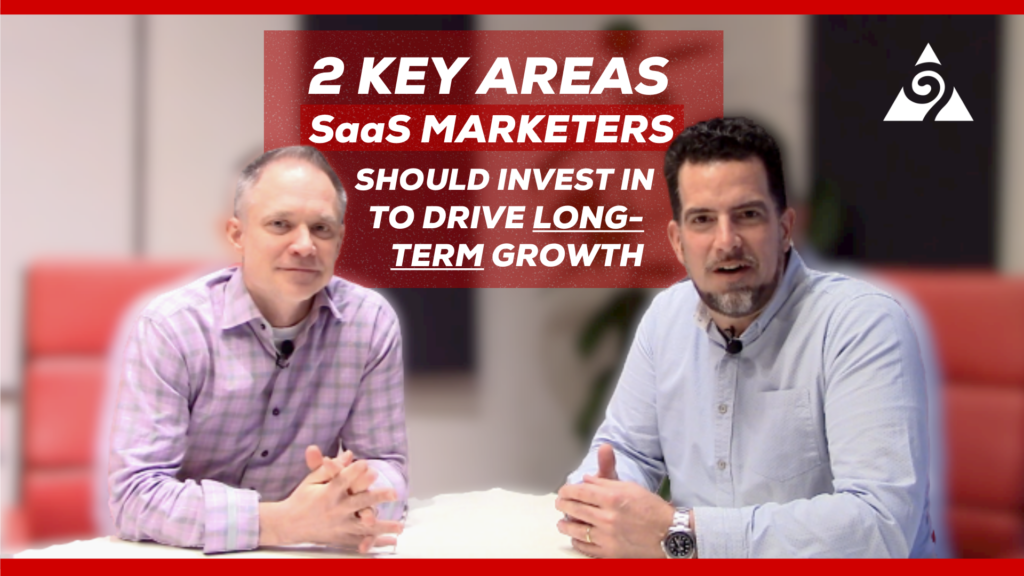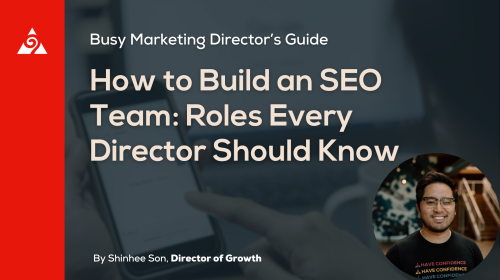SaaS is an exciting industry to be in. These guys should know; they’ve been there before. In this video, Augurian’s founders Josh Becerra and Colin Hirdman speak about their experience in the SaaS business.
Josh and Colin highlight the two key areas that SaaS marketers should focus on to build long-term success:
- Testing
- Content
Two Key Areas SaaS Marketers Should Invest In
Explore more digital marketing tips, insights, and interviews on our blog to learn more.
Or, reach out to an Augur today to talk about your digital marketing performance.
VIDEO Transcription
[music]
Josh Becerra: Hi everybody, this is Josh Becerra, I’m here with Colin Hirdman. We thought it would be fun to talk a little bit about software as a service, SaaS. We’ve had some experience. We built a couple of SaaS products and put them into markets over the years, so we’re familiar with the development, the product-market fit and scalability around a SaaS business. Why don’t you tell them a little bit what we’ve put in the market?
Colin Hirdman: Yes, well, certainly SaaS is a niche that we have a lot of love for both in terms of our own experience with it, as well as the clients that we serve through Augurian. It has just so much incredible potential. We love tapping into that for our clients and we certainly love tapping into that when we were developing our own products as well. Just to tell you a little bit about the experiences that we had, in the early days of Twitter, we created a product called LocalTweeps–
Josh: This is like early days, 2008, let’s say, something like that, right?
Colin: Yes, 2008. What we wanted to do was to allow Twitter users to find each other locally and build those local connections amongst Twitter users. We created a product that you would log in to our product with your Twitter profile, you’d put in your zip code, and then that would associate you with a city and a state. Then a tweet would go out on behalf of your account to all of your followers, letting you know that you just signed up on LocalTweeps, which is a local directory. We signed up like 30,000 users in two days, we got a lot of press coverage, [crosstalk]. It was really awesome, but we didn’t have a monetization strategy, so we didn’t really make any money off of it, but that experience parlayed into SMBTweet.
Josh: Well, and I’ll just say that viral loop that we created where when somebody signed up, a tweet actually went out, I think that was a big learning that we had, was creating that viral loop.
Colin: Yes. I know the viral loop was fantastic. If you can get a viral loop going on your SaaS product, [crosstalk]
Josh: That’s the way to go.
Colin: Yes. Then, SMBTweet came along where we really sympathized with small, medium-sized businesses, wanting them to be able to create a following on Twitter where they just didn’t have the time or really the understanding of how to do it well. We built an algorithm based off of the way a human would build a following correctly on Twitter and launched that product. Really what the product did is it allowed a small or medium-sized business to put in specific keywords and geographies and find people that would be likely to follow them back, like a local pizza shop or a local barber or things like that, or dentist, create a following without it being spammy and really help that vibrant culture of Twitter take hold locally.
Unfortunately, with Twitter changing their terms of use, we had to submarine that product.
Josh: Yes, that was too bad.
Colin: We were generating really good revenue off of it and a lot of great experiences and happy customers, but lesson learned on billing on top of somebody else’s platform.
Josh: Yes, and just having tasted the sweet nectar of SaaS revenue where someone pays you monthly to interact with a piece of software, we didn’t really have a huge customer service or support situation, so it was really nice. SaaS is a great business model if you can make it work.
Colin: Yes, [unintelligible 00:03:49] those experiences. We have plenty of other products that we’ve brought to market, but don’t need to get into those any further. That SaaS definitely [unintelligible 00:04:00] product is definitely in our hearts something that we really enjoy building and we’ll continue to experiment with.
Josh: Yes. We have SaaS clients obviously at Augurian that we service, and we have our own experience that we can reflect on. I think prior to starting to film this video, we talked a little bit about two key areas where we think it’s important that SaaS marketers are really focused. The two areas are around testing, and then the second one is content. Maybe we could talk first a little bit about testing.
Colin: Yes. A lot of what testing is you’re trying to figure out your product-market fit that goes in terms of the audiences that you’re trying to build and get in front of. Who are those buyers? Then also around pricing models and trying to understand what are people willing to pay and how do we get them on these recurring subscriptions that they feel really good about? There’s a lot of tools within digital to really hone in on those audiences, and so ensuring that your site is firing the pixels correctly, ensuring that you understand the audiences can get built around Google Analytics, through Google Ads, through Facebook and Instagram and the other social platforms is really key.
Those audiences will allow you to narrow in and build out personas, and these personas will allow you to target them through content, through paid advertising. That’s one of the areas that really [unintelligible 00:05:30] on with clients, is the opportunity to build audiences. I’ve even heard it said that platforms like Google Ads are moving away from really more keyword-driven and more toward audience-driven. Audiences are really big, especially having those audiences and having that as first-party data.
Once you have that, it really turns into, from a paid perspective, how are you spending your budget? We use a bimodal framework for that, where there is the core where about 70-80% of your ad spend is going toward tried and trued methods where you’re able to deliver a return on investment, but that you’re also experimenting. The publishers, Google, Facebook, et cetera, they want you to experiment. They want you to test, and you get rewarded for doing that both in terms of what the publishers offer you, but also the learnings that you get from it.
Really that bimodal framework of where you have budget dedicated to core, but then also you have budget dedicated to experimentation within your advertising. Then finally, CRO, conversion rate optimization, really testing across the landing pages on your site, really understanding what types of language, what types of imagery is getting people along that customer journey to convert.
Josh: Yes. I think CRO can be a really interesting way to do some testing around like, “What is my call to action? Do we offer a 30-day free trial? How is our pricing look?” All of these things can be tested. Once you’ve established these audiences and you’re bringing them in, running these AB tests are critical to see, “Are there ways that we can get a higher percentage of people to either start that free trial or start that subscription?” Getting people to move down the funnel quicker is the special sauce to software as a service.
Colin: Yes, which gets us moving to content.
Josh: Yes. Content is another big thing. We look at content from a customer journey perspective. There’s people who have an unmet need and they start searching on that unmet need, and they might not even have the vocabulary or industry jargon yet. That’s really high funnel content that needs to be created. As you move through that funnel all the way down to where they have now incorporated all the jargon and they understand the industry or what they’re actually looking for very clearly, now they’re starting to do branded search and things like that. Content is vastly important throughout this customer journey, won’t you say?
Colin: Absolutely. I think when you think about content from a perspective of content where it’s directly related to what you’re selling, you need to ensure that users, potential customers understand exactly what the product is and what it does. There’s that side of it. The other side of it then is kind of that ancillary content, which is, my product is related to these types of searches and topics. Where you can create content that is getting, like you said, people higher funnel that are looking for solutions or looking to be educated.
One of the axioms that we hear is, people buy from where they get educated. As you’re building out that content on your site, really being strategic and ensuring that the content that you’re creating is educating, but also directing people toward how your product can augment whatever it is that they’re searching on and whatever kinds of education they’re looking for.
Josh: Depending on what you’re selling, you’re going to really need to decide, can the topics for that content come from search volume? Can you actually use SEO principles to do some of the keyword research necessary to understand what are even the topics that people are talking about within this customer journey? Where are there opportunities where there might be a certain topic within a certain stage of that customer journey that isn’t being answered very clearly that you could actually provide the best answer for that topic or question? That’s one way to really approach SaaS content, is to say, “What are the volumes of searches from an SEO perspective around the topics that
are related to our product or our service?” Then understanding all those different topics, where do they fit in that customer journey, how well your company is doing versus the competition on answering those questions, and then where there might be opportunities. We’ve seen that to be a really great way for companies, especially SaaS, to start informing what types of content that they should be writing.
Colin: Yes, and we’ve seen that from just a data perspective, the metrics show that that strategy works. That when you’re compounding really, really great content around a customer journey and Google can see that you’re creating this great content and you’re creating it over time, and you’re staying up to date in what you’re creating, then you start to get rewarded for that content. I think in a lot of ways, large companies– We’ve seen Home Depot really dominate the windows and doors and kind of home industry with all the content they’ve created over the last decade and really outdistance themselves from competitors like Lowe’s because they’ve just been really dedicated to that effort.
From a content perspective, it really does pay off by just being diligent and really understanding from a metrics and data perspective, what is it that our customers are [unintelligible 00:11:20] to get educated about? How can we create that content, create it consistently over time, and then have that draw them in and start seeing our product as being an answer to whatever ails them.
Josh: Yes. Well, there you go. From a SaaS marketer perspective, know that we have a lot of experience with our own SaaS products. We also help a lot of companies that are in the SaaS space get results online, and know that testing and content are two huge pillars to having success when approaching your digital marketing. That’s it for today. Thanks everybody.
Colin: Thank you.
Josh: See you next time.
[00:12:05] [END OF AUDIO]



